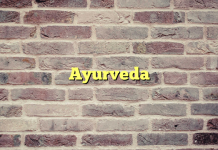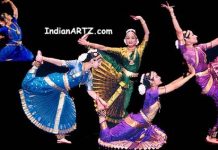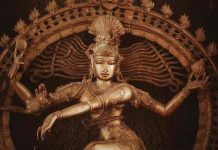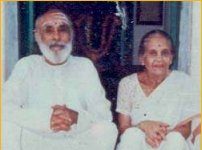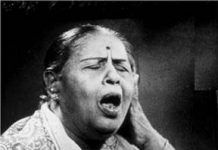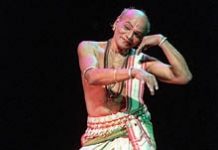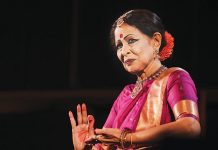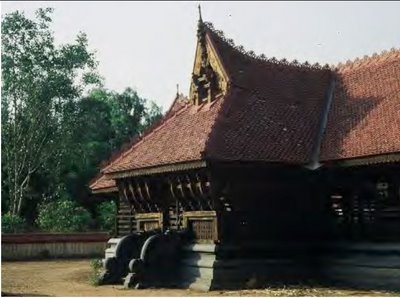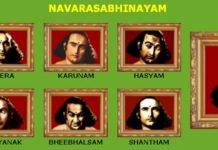Kathakali is ancient and classical in nature and holds centuries of tradition and culture. It is not simply a dance-drama but an act of devotion featuring the universal struggle between good and evil.
Kathakali takes place in a variety of places from a beautifully constructed Kootambalam – story temple – or in a simple temporary canopy made from coconut leaves covering a platform made of earth in a village temple or a garden. The dressing room would be close to the stage with the walls made from coconut leaves also.
The actual Kathakali performance usually starts between 9 and 10 pm with Arrangu Keli – a drumming piece played on the Madalam drum to ask the Gods for their blessings and to invite them to watch the performance. [To perform Kathakali is a great honour and performed to the Gods as an act of devotion.]
A large brass oil lamp called a Valika, is placed at the front of the stage. Lighting the lamp is highly symbolic act and when lit, it illustrates that there is divine prescence.
Todayam– is a dance ritual that is performed behind a large brightly coloured satin curtain held up by two men at the front of the stage and called a Tereshiela. Two junior actors perform a composition of pure dance accompanied by the SUDDHA MADALAM drum- solo Madalam.
Todayam is the first item to be learned by a young Kathakali student to test his ability to balance, keep classical positions, maitain rhythm, use Mudras and understand facial expressions.
The Vandana slokam is a prayer and follows Todayam to bless the stage and to receive the Gods. The first actors make their way to the stage but before leaving the dressing room they will go to all the senior artists, touch their feet and ask for their blessings, pray to the Valika – lamp – situated in a corner of the green room and finally go onto the stage that is now a holy place.
The actors make their journey from this world into the world of the Gods with dignity and humility.
Purappad
– means starting point and represents the beginning of the Kathakali performance, traditionally performed by students to develop their skills. The actors represent the main characters of the story – Krishna or Balarama and is performed as a piece of pure dance, sometimes accompanied by the relevant female partners.
Melepadam– is a musical master piece where senior singers and drummers are given an opportunity to perform their outstanding skills.
The singers express dedication and appreciation to Jaya Deva who wrote the great poemsof the Geetha Govindam in the 11th century. Singing his poems creates a melody of exquisite beauty. People travel many miles to see the top artists perform Melepadam as a piece of vibrant music in its own right.
The Kathakali play– the actual Kathakali story starts when Melepadam finishes. The audience have been stimulated by powerful drumming, bathed in superb singing and inspired by rituals and ceremonies. The whole experience is in preparation for the full impact of a Kathakali play to descends on to the stage and depict stories from the great Hindu epics.
Normally two or three plays are performed throughout the night starting with a love story or one featuring every day life, saving the last story for an almighty battle when good conquers evil. Just before the sun rises in the cool early morning sky this victory symbolises a new beginning as the light blesses the earth.
The temples hold annual festivals where the community is encouraged to live with more compassion and care for each other.Throughout the night the audience and artists have engaged in a universal journey where goodness prevails over evil to illustrate the path to a better life.
Danasi
Danasi is a dance ritual performed as the sun rises by one of the good characters in the story, usually Lord Krishna or Lord Siva. He asks for blessings on the audience and gives salutation to the Gods for the night that they came to earth.
After the performance it is a social time for the artists where everyone winds down, takes a bath in the temple tank or river, eat breakfast and move onto the next temple performance. It is extremely hard work to perform throughout the night and results in a close family atmosphere within the Kathakali group.
Many years of quality training and experience is required to create a Kathakali artist. Each one is respected for the specialised skills that they bring to the stage to present one of the most moving and unforgettable experiences of all.
DRAMA
Kathakali is very different from other classical Indian – drama styles and performed as a group with a variety of characters. A Kathakali performer is known as an actor and not a dancer and a performance is called a play. Kathakali plays are about complex human relationships with each character representing a different symbolic level of consciousness from the Gods to the most evil.
The actor translates the story through stylised body language, gesture and deep emotion.
Source: kathakali.net

![PANCHAKARMA [ Detoxification ] PANCHAKARMA [ Detoxification ]](https://indianartz.com/blog/wp-content/uploads/2017/07/PANCHAKARMA--Detoxification--218x150.png)
